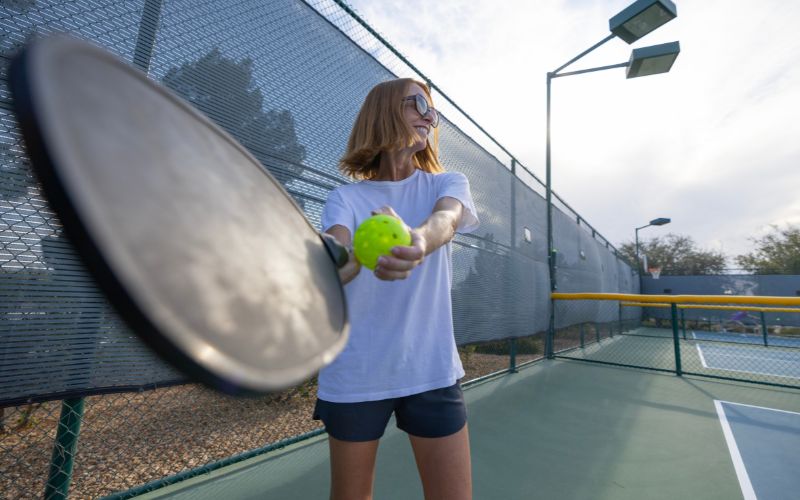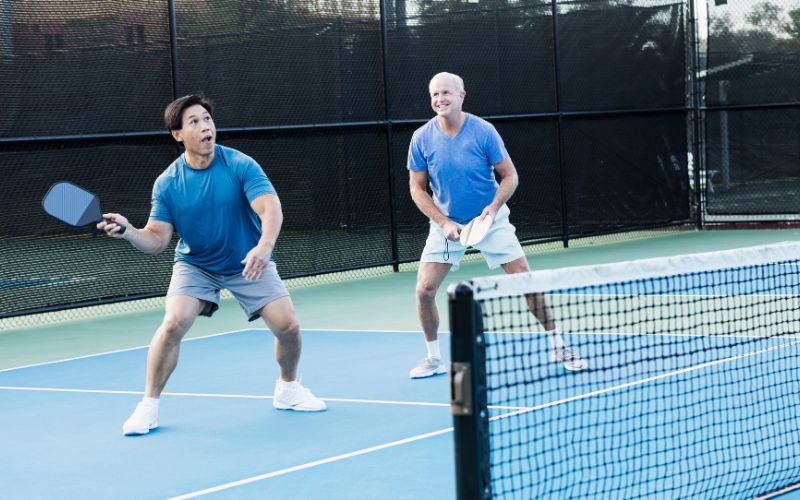Pickleball, often hailed as one of the fastest-growing sports in America, combines elements of tennis, badminton, and ping-pong. It’s a game that’s easy to learn but challenging to master, making it accessible to players of all ages and skill levels. One common question that arises among pickleball enthusiasts is, “Can you hit overhand in pickleball?” Let’s delve into this query and explore the dynamics of overhand shots in pickleball.
Understanding Overhand Shots in Pickleball
What Constitutes an Overhand Shot?
In pickleball, an overhand shot refers to striking the ball while the paddle head is above the wrist during the point of contact. Unlike the traditional underhand shots commonly seen in pickleball, which involve a swinging motion below the waist level, overhand shots are executed with an upward arc, typically at or above waist level.
Legal Aspects of Overhand Shots
According to pickleball rules, hitting the ball overhand is entirely permissible, provided it’s done within the boundaries of the game’s regulations. The rule book doesn’t restrict players from employing overhand shots during gameplay. However, executing these shots effectively requires proper technique and timing.
At What Point Is It Permissible to Execute an Overhand Shot in Pickleball?
If you’ve had experience with tennis, you understand the potency of an overhand top spin shot, particularly from the baseline. This type of shot engages multiple muscles and enables greater power generation through a full arm swing compared to an underhand stroke. Essentially, it represents a more assertive offensive maneuver. When employing the overhand technique in pickleball, you adopt an aggressive stance, entering into an offensive mode. Nevertheless, there are limitations regarding when you can execute overhand shots, and it’s not advisable to attempt them indiscriminately or on every shot.
When Is the Opportune Moment to Employ Overhand Shots in Pickleball?
Here are some guidelines and strategies to consider:
- Overhand serves are not permitted, so we will explore proper techniques for this later in the article.
- Following each serve, players are permitted to utilize overhand shots in pickleball. Whether it’s the serving team or the opposing team serving, players have the liberty to execute an overhand shot upon the return of the ball to their side of the court.
- The most impactful overhand shot in pickleball is the overhead smash, as highlighted by NCSU. Overhead smashes are renowned for their sheer power and effectiveness in the game.
- When faced with a high, arcing shot from the opponent that descends towards your side of the net, it presents an ideal opportunity for an overhand smash. The elevated trajectory allows for a downward strike on the ball, enhancing the effectiveness of the shot.
- Conversely, attempting an overhand hit when the ball bounces low is ill-advised. Overhand shots are most effective when the ball is at or above shoulder height.
- If the ball is positioned near your waist, executing an overhead shot becomes challenging. In such instances, opting for a subtle underhand dink to keep the ball low is preferable.
- When hitting from the baseline, generating maximum power is achievable by employing a forehand with overhand topspin.
- Controlling the trajectory of an overhand hit is notably easier compared to an underhand hit, providing players with greater precision and command over their shots.
- Overhand shots serve as a strategic tool to force opponents away from the net and compel them towards the baseline.
- Even when positioned at the net, executing a well-placed drive shot with overhand topspin can effectively drive opponents backward, altering the dynamics of the game.
Step-By-Step Guide to Mastering the Overhand Hit in Pickleball
- When the ball approaches your vicinity, position yourself with your dominant hand placed behind your body. Adopt a sideways stance with your feet firmly grounded. Ensure that the ball bounces high enough to allow for contact, although this won’t always be feasible for every shot.
- As the ball draws nearer, rotate your body to align your hips and feet, simultaneously swinging your dominant hand’s paddle toward the ball. The critical juncture lies in making contact, where you have the opportunity to dictate whether the ball rises or descends. This phase significantly influences the outcome of the shot.
- For an overhead smash, exert maximum force upon striking the ball. Conversely, if aiming for a gentle touch to direct the ball, adjust your hips and arm accordingly, paying close attention to wrist control for trajectory adjustment.
- In instances where the ball surpasses your head, initiate a jump just before swinging. Maintain the twisting stance even when the ball is considerably above your head, within manageable reach.
- Conceptualize your body as a coiled spring, poised to unleash upon the ball’s proximity. As the ball nears, release the stored energy for a forceful impact.
- Immediately after contact, root your feet and remain vigilant for your opponent’s subsequent move. Expect swift reactions from opponents, as overhead smashes carry an imposing presence on the court.
Perfecting the Overhand Shot
Proper Technique Matters
Achieving a perfect overhand shot in pickleball involves mastering the proper technique. Unlike the underhand stroke, which relies on wrist action and a low-to-high swing, the overhand stroke requires a different approach. Players must position themselves correctly, maintain balance, and execute a fluid swing to generate power and accuracy.
Body Positioning and Footwork
Before attempting an overhand shot, players should position themselves correctly relative to the incoming ball. The front foot should be positioned slightly forward, allowing for better weight transfer and balance during the swing. Additionally, maintaining a stable stance with the feet shoulder-width apart enhances control and power generation.
Swing Mechanics and Paddle Angle
The key to a successful overhand shot lies in the mechanics of the swing and the angle of the paddle. Players should initiate the swing from the shoulder rather than the wrist, allowing for a smoother and more powerful stroke. As the ball approaches, the paddle should be angled slightly upward to facilitate a clean contact point.
Incorporating Overhand Shots into Gameplay
Strategic Considerations
Overhand shots can be valuable weapons in a player’s arsenal, especially when used strategically during a pickleball game. Unlike underhand shots, which tend to produce a high bounce and predictable trajectories, overhand shots offer greater versatility and unpredictability. Players can exploit their opponents’ positioning and court coverage by mixing up their shot selection and incorporating overhand strokes into their gameplay.
Partner Communication and Coordination
In doubles pickleball, effective partner communication is essential when employing overhand shots. Players must communicate their intentions and coordinate their movements to avoid collisions and maximize court coverage. Clear and concise communication helps ensure that both players are on the same page and can anticipate each other’s actions during intense rallies.
Practice Makes Perfect
As with any skill in pickleball, mastering the overhand shot requires practice and dedication. Players should dedicate time to hone their technique, refine their timing, and develop consistency in executing overhand shots. By incorporating focused drills and simulated game scenarios into their training regimen, players can enhance their proficiency and confidence in hitting overhand shots during competitive play.
Conclusion
In conclusion, the answer to the question, “Can you hit overhand in pickleball?” is a resounding yes. Overhand shots add an exciting dimension to pickleball gameplay, offering players additional options for generating power, accuracy, and strategic advantage. By mastering the proper technique, understanding strategic considerations, and committing to consistent practice, players can incorporate overhand shots into their repertoire and elevate their performance on the pickleball court.
Whether you’re a beginner learning the basics or a seasoned competitor refining your skills, embracing the versatility of overhand shots can enhance your enjoyment and success in the dynamic world of pickleball. So go ahead, practice your overhand strokes, and unleash the full potential of your game on the pickleball court!
FAQs on Overhand Shots in Pickleball
1. Is hitting overhand allowed in pickleball?
Yes, hitting the ball overhand is entirely permissible in pickleball, as long as it’s done within the boundaries of the game’s regulations. The rule book doesn’t prohibit players from using overhand shots during gameplay.
2. When can I execute overhand shots in pickleball?
Overhand shots are permitted after each serve and during rallies when the ball comes back over to your side of the court. Whether you’re serving or returning, you have the freedom to utilize overhand shots strategically during gameplay.
3. What is the most effective overhand shot in pickleball?
The overhead smash is widely regarded as the most impactful overhand shot in pickleball. Renowned for its power and effectiveness, the overhead smash offers players a formidable offensive option during intense rallies.
4. When should I avoid attempting overhand shots in pickleball?
It’s advisable to avoid overhand shots when the ball bounces low or is positioned near your waist. Overhand shots are most effective when the ball is at or above shoulder height, allowing for better control and power generation.
5. How can I improve my technique for executing overhand shots in pickleball?
Mastering the proper technique for overhand shots involves focusing on body positioning, footwork, swing mechanics, and paddle angle. Practicing drills and simulated game scenarios can help enhance proficiency and confidence in executing overhand shots during competitive play.




